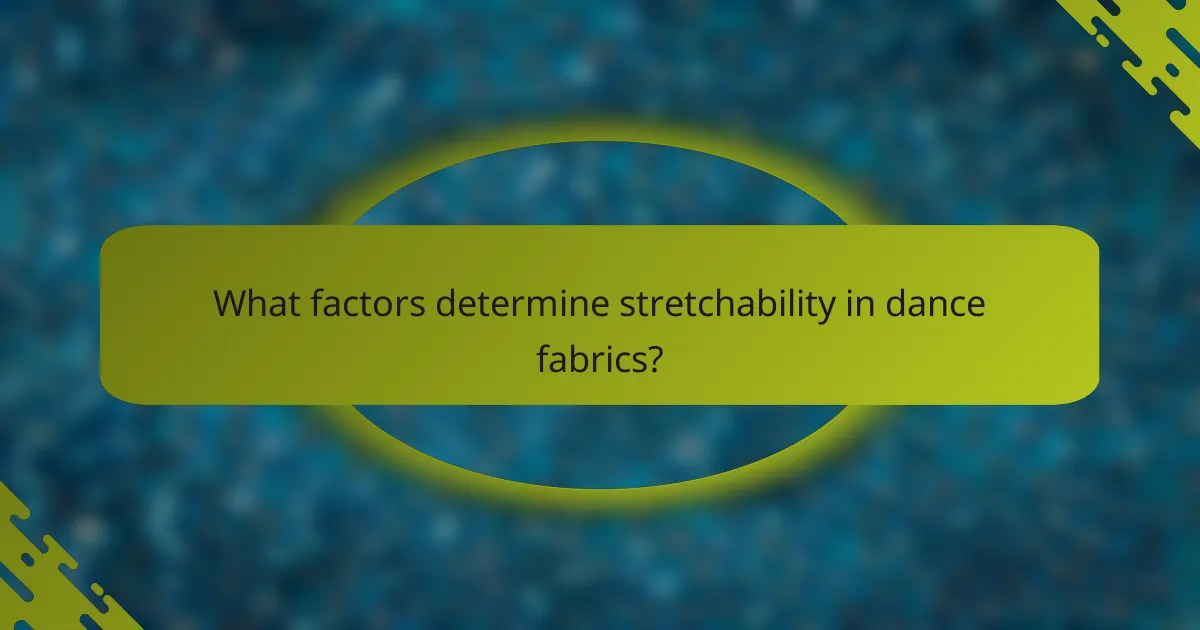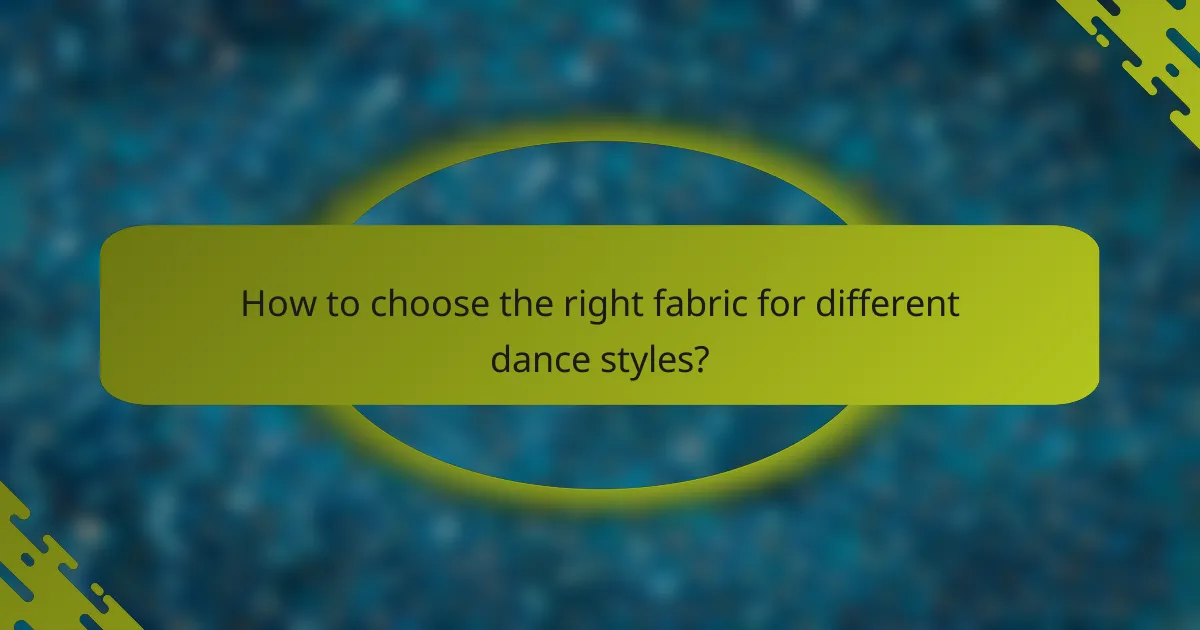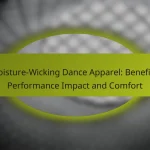Choosing the right dance fabrics is essential for enhancing performance, as they prioritize flexibility, breathability, and moisture management. Breathable materials help regulate body temperature and maintain comfort during intense movements, while stretchable fabrics ensure freedom of movement. Understanding the composition and elasticity of these fabrics allows dancers to select the best options for their specific needs.

What are the best dance fabrics for performance?
The best dance fabrics for performance prioritize flexibility, breathability, and moisture management. These materials enhance movement while ensuring comfort, making them essential for dancers of all styles.
Moisture-wicking polyester
Moisture-wicking polyester is a popular choice for dance apparel due to its ability to draw sweat away from the body. This fabric keeps dancers dry and comfortable during intense routines, which is crucial for maintaining performance levels.
When selecting moisture-wicking polyester, look for options with a smooth finish and a lightweight feel. Many brands offer blends that enhance durability while retaining breathability, making them ideal for both practice and performances.
Stretchable spandex
Stretchable spandex is essential for dancewear, providing the necessary elasticity for a full range of motion. This fabric allows for dynamic movements, ensuring that garments fit snugly without restricting movement.
Consider spandex blends with other materials for added comfort and breathability. A typical blend might include cotton or polyester, which can enhance durability while maintaining the stretch needed for various dance styles.
Breathable cotton blends
Breathable cotton blends combine the softness of cotton with synthetic fibers to enhance moisture management and stretch. This fabric is comfortable against the skin and allows for airflow, making it suitable for warm environments.
When choosing breathable cotton blends, look for those with a higher percentage of synthetic fibers for better performance. These blends are often used in casual dancewear and can be a great option for rehearsals.
Durable nylon
Durable nylon is known for its strength and resistance to wear, making it an excellent choice for dance costumes and practice wear. This fabric holds its shape well and can withstand the rigors of frequent use.
For optimal performance, select nylon fabrics that include moisture-wicking properties. This combination ensures that dancers remain comfortable and dry while enjoying the durability that nylon offers.
Lightweight mesh
Lightweight mesh is often used as an overlay or in panels to enhance breathability in dancewear. This fabric allows for airflow, making it ideal for high-energy performances where temperature regulation is essential.
When incorporating lightweight mesh into dance costumes, ensure it is paired with more substantial fabrics for support. This combination provides both style and functionality, allowing dancers to move freely while looking great on stage.

How does breathability impact dance fabrics?
Breathability in dance fabrics is crucial as it directly affects a dancer’s performance and comfort. Fabrics that allow air circulation help regulate body temperature and prevent excessive sweating during intense movements.
Prevents overheating
Breathable fabrics help prevent overheating by allowing heat and moisture to escape from the body. This is particularly important during vigorous dance routines where body temperature can rise significantly. Fabrics like mesh or lightweight cotton blends are often preferred for their ability to wick away sweat and keep dancers cool.
Enhances comfort
Comfort is vital for dancers, and breathable materials contribute significantly to this aspect. Fabrics that allow for airflow reduce the likelihood of chafing and irritation, which can occur with less breathable options. Choosing materials with good breathability can make long rehearsals or performances much more enjoyable.
Improves airflow
Improved airflow in dance fabrics enhances overall performance by ensuring that dancers remain dry and comfortable. Fabrics designed with ventilation features, such as perforations or open weaves, facilitate better air circulation. This not only helps in temperature regulation but also supports better focus and movement during performances.

What factors determine stretchability in dance fabrics?
Stretchability in dance fabrics is primarily influenced by the fabric composition, weave structure, and elasticity percentage. Understanding these factors helps dancers choose the right materials for optimal performance and comfort.
Fabric composition
The type of fibers used in a fabric significantly affects its stretchability. Common materials like spandex, lycra, and nylon offer high elasticity, while cotton provides less stretch. Blends of these fibers can enhance performance by combining comfort with flexibility.
When selecting dance fabrics, consider the intended use. For example, fabrics with a higher spandex content are ideal for styles requiring extensive movement, such as ballet or contemporary dance.
Weave structure
The weave structure of a fabric determines how it behaves under tension. Knitted fabrics typically offer more stretch than woven fabrics due to their looped construction, allowing for greater flexibility and comfort during movement.
For dancers, choosing a fabric with a suitable weave structure can enhance performance. For instance, a four-way stretch knit allows for multidirectional movement, making it preferable for dynamic dance styles.
Elasticity percentage
Elasticity percentage refers to the amount of stretch a fabric can achieve without losing its original shape. Fabrics with an elasticity percentage of around 15-30% are generally considered suitable for dance, providing a balance between support and flexibility.
When evaluating dance fabrics, check the label for elasticity details. A higher percentage indicates better stretchability, which is crucial for movements that require significant flexibility, such as jumps and splits.

Which dance fabrics are popular in the UK?
In the UK, popular dance fabrics include Supplex nylon, microfiber blends, and modal fabrics. These materials are favored for their performance, breathability, and stretchability, making them ideal for various dance styles.
Supplex nylon
Supplex nylon is a lightweight, durable fabric known for its excellent breathability and moisture-wicking properties. Dancers appreciate its ability to keep them dry and comfortable during intense performances.
This fabric offers a good amount of stretch, allowing for freedom of movement while maintaining shape. When selecting Supplex nylon garments, look for options with a blend of spandex for enhanced elasticity.
Microfiber blends
Microfiber blends combine polyester and nylon to create a soft, lightweight fabric that is both breathable and stretchy. This material is often used in dancewear because it provides a comfortable fit and allows for a full range of motion.
When choosing microfiber blends, consider those with added elastane for improved stretch. These fabrics are also easy to care for, making them a practical choice for regular use in dance classes and performances.
Modal fabrics
Modal fabrics are made from beech tree pulp and are known for their softness and breathability. This fabric drapes beautifully, making it suitable for dance styles that require fluid movement.
While modal offers good stretch, it is essential to check for blends that include spandex to ensure optimal performance. Modal is also environmentally friendly, appealing to dancers who prioritize sustainable fashion choices.

How to choose the right fabric for different dance styles?
Selecting the right fabric for various dance styles is crucial for performance and comfort. Consider factors like flexibility, breathability, and durability to enhance your movements and overall experience.
Ballet: lightweight and flexible
Ballet requires fabrics that are lightweight and flexible to allow for graceful movements and extensions. Common choices include cotton blends, spandex, and chiffon, which provide the necessary stretch and support.
When choosing ballet attire, look for materials that offer a snug fit without restricting movement. Fabrics should also be breathable to keep dancers cool during practice or performances.
Hip-hop: durable and stretchy
Hip-hop dance demands fabrics that are both durable and stretchy to withstand vigorous movements and routines. Materials like polyester blends and cotton jersey are popular due to their resilience and comfort.
Opt for fabrics that allow for a full range of motion while maintaining their shape. Loose-fitting styles are common, but ensure the fabric can handle the intensity of hip-hop choreography without tearing or losing elasticity.
Contemporary: breathable and soft
Contemporary dance combines elements from various styles, requiring fabrics that are breathable and soft. Natural fibers like bamboo or modal, along with blends containing spandex, are ideal for this style.
Choose materials that feel gentle against the skin and allow for fluid movement. Look for options that provide both comfort and flexibility, enabling dancers to express themselves freely during performances.

What are the care instructions for dance fabrics?
Proper care instructions for dance fabrics ensure longevity and maintain performance qualities. Most dance fabrics require specific washing and drying methods to preserve their breathability and stretchability.
Machine wash cold
Machine washing dance fabrics in cold water is essential to prevent shrinking and fading. Cold water helps maintain the integrity of the fibers, ensuring that the fabric retains its shape and elasticity.
When washing, use a gentle cycle to minimize agitation, which can lead to wear and tear. It’s advisable to turn garments inside out to protect the outer surface from friction and potential damage.
For best results, use a mild detergent that is free from harsh chemicals. Avoid bleach, as it can weaken the fibers and alter the color of the fabric.










